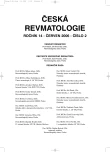-
Medical journals
- Career
The role of osteoprotegerin in diffuse idiopathic skeletal hyperostosis and ankylosing spondylitis
Authors: O. Kryštůfková; Š. Forejtová; H. Hulejová; M. Braun; J. Gatterová; M. Hladíková 1; K. Pavelka; J. Vencovský
Authors‘ workplace: Revmatologický ústav, Praha, 1Ústav lékařské informatiky, 2. LF UK Praha
Published in: Čes. Revmatol., 14, 2006, No. 2, p. 53-64.
Category: Original Papers
Overview
Objective:
Diffuse idiopathic skeletal hyperostosis (DISH) and ankylosing spondylitis (AS) represent diseases with distinct etiological patterns that cause hyperossification of the spine. Osteoprotegerin is a decoy receptor that binds RANKL (receptor activator of nuclear factor-κB) and thereby competitively inhibits differentiation and activation of osteoclasts. The aim of this study was to find out the role of serum osteoprotegerin (S-OPG) with respect to the ectopic bone formation or osteoporosis in patients with DISH and AS, respectively.Methods and materials:
Forty-four patients with AS (mean age 37.5 ± 13.7 years), 71 patients with DISH (mean age 64.8 ± 9.6 years), and 116 healthy controls (mean age 46.5 ± 16.2 years) were examined. The level of S-OPG was measured by ELISA, and serum osteocalcin (S-OC) and bone alkaline phosphatase (ALP) by EIA. The level of urine dexypyridinoline (U-DPD, EIA), and clinical assessment, spine radiography as well as bone densitometry of femur and lumber spine (BMD, DEXA) were performed in all the patients. Disease activity of AS was estimated according the C-reactive protein (CRP), erythrocyte sedimentation rate (ESR) and the mean BASDAI.Results:
Patients with AS were younger than those with DISH, had higher ESR and CRP. Those with high disease activity according to BASDAI were prevalent. Age-adjusted levels of S-OPG were similar between patients with AS, DISH as well as in healthy controls. Likewise, the difference in S-OC, bone ALP, and U-DPD between those two diseases was also not observed. Moreover, the patients had significantly higher levels bone-formation markers S-OC (p<0.0005 for AS and DISH) and bone ALP (p<0.0005 and p=0.066 for DISH and AS, respectively) in contrast to healthy controls. The levels of U-DPD were above the upper reference range in significantly more patients (AS: 30% and DISH: 29%). AS patients with high disease activity according to ESR had lower bone ALP and S-OC, and according to BASDAI had lower S-OC compared to the patients with low activity (p<0.05). Prevalence of osteoporosis and osteopenia was higher in patients with AS (35%) compared to those with DISH (14%). In 50 years old and younger AS patients, ESR correlated negatively with S-OC as well as with bone ALP (cc= -0.476, p<0.005, cc= -0.325, p=0.06, respectively). Moreover, tight positive correlation between S-OPG and BMD of lumbar spine and femur (cc from 0.35 to 0.43, p<0.05) was also observed. Patients with AS and osteoporosis had lower S-OPG levels than those without osteoporosis.Women with DISH presented lower lumbar spine and femur BMD and higher U-DPD and bone ALP than men.Conclusion:
With respect to similar levels of S-OPG, increased levels of S-OC as well as bone ALP, and no association between S-OPG and markers of bone turnover, we propose that hyperossification in both diseases is not the result of insufficient bone resorption but rather the result of abnormal activity of osteoblasts. Frequent decrease of BMD, positive correlation of BMD with serum levels of OPG as well as decrease of bone formation markers during the active disease indicate a putative role of inflammation in the onset of osteoporosis in AS. The decrease of BMD in the line with the changes of bone turnover markers in women with DISH is most probably related to the development of metabolically active postmenopausal osteoporosis.Key words:
diffuse idiopathic skeletal hyperostosis, ankylosing spondylitis, osteoprotegerin, ectopic formation, osteoporosis
Labels
Dermatology & STDs Paediatric rheumatology Rheumatology
Article was published inCzech Rheumatology

2006 Issue 2-
All articles in this issue
- Immunolocalization of 3-nitrotyrosine in human synovium
- The role of osteoprotegerin in diffuse idiopathic skeletal hyperostosis and ankylosing spondylitis
- The role of synovial fibroblasts in the pathogenesis of rheumatoid arthritis
- Complex morphological examination of patients with ankylosing spondylitis
- The role of vitamin D in prevention and therapy of glucocorticoid-/inflammation-induced osteoporosis
- Osteoporosis in some inflammatory rheumatic diseases
- Czech Rheumatology
- Journal archive
- Current issue
- Online only
- About the journal
Most read in this issue- Osteoporosis in some inflammatory rheumatic diseases
- Complex morphological examination of patients with ankylosing spondylitis
- The role of synovial fibroblasts in the pathogenesis of rheumatoid arthritis
- The role of vitamin D in prevention and therapy of glucocorticoid-/inflammation-induced osteoporosis
Login#ADS_BOTTOM_SCRIPTS#Forgotten passwordEnter the email address that you registered with. We will send you instructions on how to set a new password.
- Career

